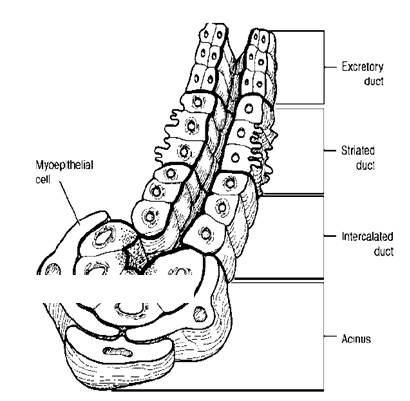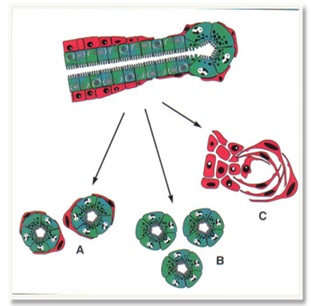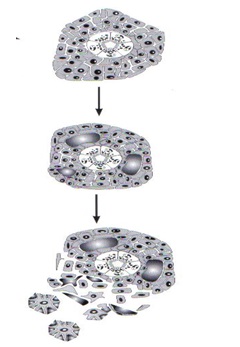Introduction
In the second half of the 20th century, the field of salivary gland tumor pathology proved fertile ground for the identification of a considerable number of new entities. This is evidenced by the 16 salivary tumor entities listed in the 1954 AFIP fascicle classification of Foote and Frazell compared with 36 entities in the 1996 AFIP fascicle authored by Ellis and Auclair [1,2]. Since 1954 there has been a doubling in tumor categories of both benign (6 now 13) and malignant (10 expanded to23) [3]. There has not been a single universally used classification system for salivary gland tumor [4]. The latest WHO 2005 has added many new entities by classifying salivary gland tumors into epithelial and mesenchymal and further sub classified into benign and malignant. Softtissue tumors (Hemangioma), Hematolymphoid tumors (e.g. Hodgkin lymphoma), Secondary tumors are categorized under mesenchymal malignant lesions [5].
WHO 2005 Classification
I. Epithelial tumors
A. Benign epithelial tumors
Pleomorphic adenoma
Myoepithelioma
Basal cell adenoma
Oncocytoma
Canalicular adenoma
Warthins tumors
Cystadenoma
Papillary cyst adenoma
Mucinous cyst adenoma
Benign sebaceous neoplasm
Sebaceous adenoma
Sebaceous lymphadenoma
Ductal papilloma
Intraductal
Inverted ductal
Sialadenoma papilliferum
B. Malignant epithelial tumors
Mucoepidermoid carcinoma
Acinic cell carcinoma
Adenoid cystic carcinoma
Polymorphous low grade adenocarcinoma
Epithelial myoepithelial carcinoma
Clear cell carcinoma
Basal cell adenocarcinoma
Oncocytic carcinoma
Myoepithelial carcinoma
Adenocarcinoma NOS
Carcinoma ex pleomorphic adenoma
Metastatising pleomorphic adenoma
Carcinosarcoma
Salivary duct carcinoma
Cyst adenocarcinoma
Low grade cribriform cystadenocarcinoma
Sialoblastoma
Malignant sebaceous tumor
Sebaceous adenocarcinoma
Sebaceous lymphadenocarcinoma
Squamous cell carcinoma .
II. Mesenchymal tumors Benign
Haemangioma
Haemangiopericytoma
Lipoma
Neurofibroma
Schwanomma
Malignant
Fibrosarcoma
Malignant fibrous histiocytoma
liposarcoma.
III. Malignant Lymphoma
IV. Metastatic tumor
However, though many of these classification schemes exist, knowing the histiogenesis and morphogenesis of tumor aids in the differentiation , classification and diagnosis of the tumor. Therefore in the article we have focused on this particular division, that is taxonomy of salivary gland neoplasm.
Basic unit of salivary glands are formed by a combination of luminal and abluminal cells [1]. The luminalcells comprise of acinar and ductal luminal cells and the abluminal cells comprises of myoepithelial cells and basal cells. The myoepithelial cells associated with acini, intercalated duct and few striated duct and is positive for CK14, muscle specific actin and the basal cells are associated with striated duct and excretory duct and is positive for CK1 and is negative for actin [6–8].
Discussion
Histiogenesis
Salivary gland tumor are histologically heterogenous group of tumors with greatest morphological diversity [1]. The process of cell differentiation refers to histiogenesis. The histiogenesis of any tumor aids in the differentiation , classification and diagnosis of the tumor. As known very well the cystic lesions have a better prognosis than the solid ones. For example Adenoid cystic carcinomas are graded based solely on pattern with solid components portending a worse prognosis [10].
The basis of histiogenic concept is to determine what type of cell in the normal salivary gland are involved in the induction of tumor. Various theories have been put forth to explain the histogenesis of salivary gland tumor, but the concept usually cited as central to the induction of these tumors is the semipluripotential bicellular reserve cell hypotheis [1] [Table/Fig-1].
Cross-section of salivary gland showing acini, dust myoepithelial cells
Courtesy: Text book on salivary gland disorders – by E N Myer, RL Ferris [9]

The four commonly postulated theories are-Basal reserve cell theory, Pleuripotent unicellular reserve cell theory, Semipleuripotent bicellular reserve cell theory, and the Multicellular concepts [7].
According to the Basal reserve cell theory the basal cells of both excretory and intercalated ducts are responsible for differentiation of functional units and thus capable of tumor formation. Pleuripotent unicellular reserve cell theory states that the basal cells of the excretory duct are responsible for the development of all remaining salivary gland unit. Semi pleuripotent bicellular reserve cell theory, the most commonly accepted theory introduced by Eversole in 1971. This theory states that the basal cell of the excretory duct form the intercalated duct and the progenitor cell of the intercalated duct are responsible for the development of acinar unit and striated duct. According to this theory only basal cells of the excretory duct and the progenitor cells of the intercalated duct are capable of cell division , while the acinar unit and striated duct are considered to be terminally differentiated cell and therefore have a minimal capacity of cell division [11].
Studies on fetal and adult salivary glands by Dardick et al., suggested that all types of cells in the normal salivary gland are capable of cell division. This formed the basis of Multicellular theory of Salivary gland histiogenesis. According to this theory, differentiated cells at all levels of the gland, including the acinar cells and striated duct can give rise to a neoplasm [12].
Morphogenesis
[Table/Fig-2]
(a) Luminal and myoepithelial cells, (b) Luminal cell, (c) myoepithelial or basic cells
Courtesy:Text book on salivary gland tumor pathology – by Dardick

Salivary gland tumor are histologically heterogenous group of tumors with greatest morphological diversity. The morphology of salivary gland tumor reflects the cellular make up of basic ductoacinar unit of normal salivary gland [6]. At each level of the salivary gland the basic unit is formed by the combination of the luminal cells or the abluminal cells, so in the salivary gland tumor, three morphogenic form can develop.
A. Tumor composed of both luminal and myoepithelial cells.
B. Tumor composed of only luminal cells.
C. Tumor composed of only myoepithelial cells/ basal cells.
Although many tumors are thought to contain both luminal and myoepithelial cells ,the histologic difference are due to:
Various forms and distribution of luminal.
(I) cells(cuboidal/columnar, sheets, islands and duct like).
(II) Various forms of myoepithelial cells (Spindle, Plasmacytoid, Clear cells).
(III) The ratio of the Ductal: Myoepithelial cells.
(IV) Presence/absence of extracellular material.
Their classification is based on three main factors, the types of cell differentiation, the pattern of tumor cell organization and the materials synthesized by the cells and their placement within the tumor. For example pleomorphic adenoma is a benign neoplasm containing both ductal, luminal and modified myoepithelial calls.The characteristic feature is the presence of chondromyxoidstroma secreted by the modified myoepithelial cells. In the initial phase GAG is secreted by the myoepithelial cells and the spaces containing these GAGs are surrounded by these myoepithelial cells. In the subsequent steps, the intercellular space enlarge by gradual separation of the myoepithelial cells, leading to the fusion of the adjacent intercellular spaces.As the space and GAG are secreted at the rapid rate, some of the myoepthelial cells get entrapped in the myxoidstroma eventually forming chondromyxoidarea.The modified myoepithelial cells can also form hyalinized stroma, osteoid ares or keratin pearl [Table/Fig-3].
Cell differentation, tumors cell, organisation and material synthesize
Courtesy:Text book on salivary gland tumor pathology – by I Dardick

Based on the histogenetic and morphogenetic concepts, two types of classification schemes for salivary gland tumors is possible. One is the taxonomic classification and the other the working classification in which the tumors are classified based on the unique histologic features and biological behavior [11].
The taxonomic classification focus on the inter relationships of various subtypes of salivary gland tumors and the developmental processes responsible for morphological nature of each subtypes of tumor and for improving diagnostic skills.
1. Neoplasms composed of luminal and modified myoepitheleial cells.
A. Histologically with apparent proteoglycan and basal lamina production.
Benign – Pleomorphic adenoma.
Basal cell adenoma.
Malignant – Malignant mixed tumor
Adenoid cystic carcinoma (cibri form pattern).
B. Histologically lacking obvious proteoglycan and basal lamina production.
Benign – basal cell adenoma.
Cellular pleomorphic adenoma.
Warthins tumor.
Malignant – basal cell adenoma.
Adenoid cystic carcinoma.
Epithelial myoepithelial carcinoma.
Mucoepidermoid carcinoma.
Polymorphous low grade adenocarcinoma.
2. Neoplasms composed primarily of myoepithelial / basal cels.
Benign – canalicular adenoma.
Ductal papilloma.
cystadednoma.
Oncocytoma.
Malignant – acinic cell carcinoma.
Salivary duct carcinoma.
Adenocarcinoma , NOS.
Oncocytic carcinoma.
3. Neoplasms composed of undifferentiated cells.
Malignant – undifferentiated carcinoma.
Small cell carcinoma.
Conclusion
The different types of carcinomas must be distinguished not only by precise histopathological definitions, but also considering differences in prognosis and treatment. For example, the polymorphous low-grade adenocarcinoma and the epithelial-myoepithelial carcinoma are characterized by a relatively good prognosis in contrast to the salivary duct carcinoma. More studies are required to differentiate salivary gland neoplasm based on the prognostic factors, which will aid in proper treatment planning.
[1]. Foote FWJ, Frazell EL, Tumors of the major salivary glands Atlas of Tumor Pathology, first series, Fascicle 11 1954 Washington, DCArmed Forces Institute of Pathology [Google Scholar]
[2]. Ellis GL, Auclair PL, Tumors of the salivary glands Atlas of Tumor Pathology, third series, Fascicle 11 1996 Washington, DCArmed Forces Institute of Pathology [Google Scholar]
[3]. Zarbo RJ, Salivary Gland Neoplasia: A Review for the Practicing Pathologist Mod Pathol 2002 15(3):298-323. [Google Scholar]
[4]. Ellis GL, Auclair P L, Gnepp DR, Text book of Surgical pathology of salivary glands 1991 Volume. 25W. BSaunders company:P129 [Google Scholar]
[5]. Barnes L, Eveson JW, Reichart P, Sidransky D, Tumours of the Salivary Glands In: Pathology and Genetics of Head and Neck Tumours 2005 LyonWorld Health Organization:209 [Google Scholar]
[6]. Dardick I, Current Status of Histogenetic and Morphogenetic Concepts of Salivary Gland tumorigenesis Critical Reviews in Oral Biology and Medicine 1993 4(5):639-6774. [Google Scholar]
[7]. Cheuk W, Chan JK C, Advances in salivary gland pathology Histopathology 2007 51:1-20. [Google Scholar]
[8]. Dardick I, Color atlas /Text of salivary gland tumor pathology 1996 Igaku-shoin medical publications:24-25. [Google Scholar]
[9]. Myers EN, Ferris RL, Salivary gland disorders 2007 BerlinSpringer:PG-10 [Google Scholar]
[10]. Raja R Seethala, An Update on Grading of Salivary Gland Carcinomas Head and Neck Pathol 2009 3:69-77. [Google Scholar]
[11]. Regezi JA, Batsakis JG, Histogenesis of salivary gland neoplasms Otolaryngologic Clinics of North America 1977 10(2):297-307. [Google Scholar]
[12]. Dardick I, Jeans MT, Sinnott NM, Wittkuhn JF, Kahn HJ, Baumal R, Salivary gland components involved in the formation of squamous metaplasia Am J Pathol 1985 119:33-43. [Google Scholar]